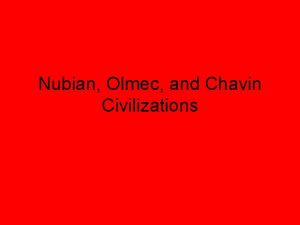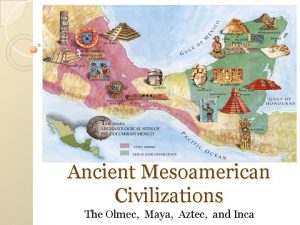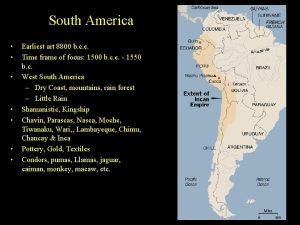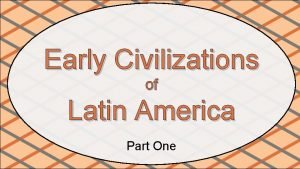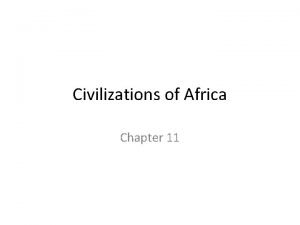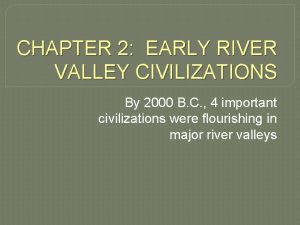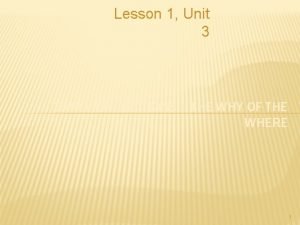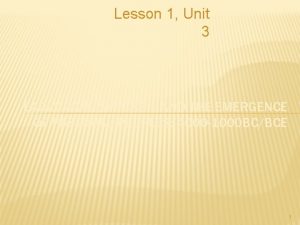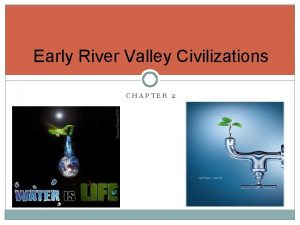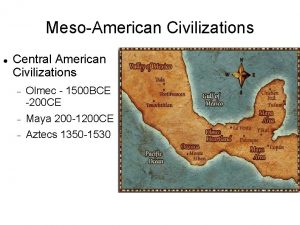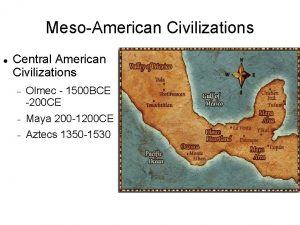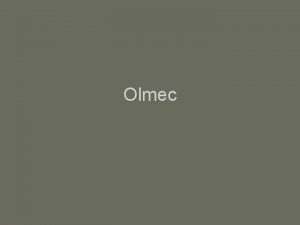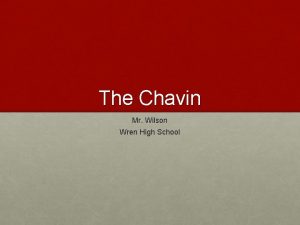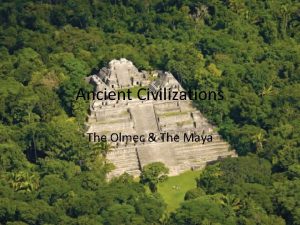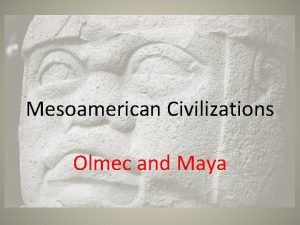Early Mesoamerican Civilizations The Olmec and the Chavin










- Slides: 10

Early Mesoamerican Civilizations The Olmec and the Chavin

The Isolated Americas �Total and complete—all the ideas, technology, agriculture, writing, etc. flying around Eurasia was absent from here �Environmental challenges: north-south axis, lots of mountains, changing terrain kept people separated and not alike �Around 1000 BC the development of some trade, some domestication of plants led to urbanization and social stratification

The Olmecs �A cultural force —considered the mother of Mexican culture �Flourished between 1200 -400 BC �Coincides with the Greeks, the Zhou, the Assyrians (western Asia), the Israelites in the Promised Land (Canaan); after the Hittites

The Olmecs �Famous for their 16 giant head sculptures probably “portraits” of important leaders �Agriculture led to development of urban areas—corn, beans, and squash, maybe manioc �As leaders emerged, they organized irrigation and public works projects �Large-scale religious and civic buildings became the cultural draw

The Olmecs �Special buildings and large artificial platforms were sites of gatherings—people would visit from surrounding areas for these �Cities laid out according to astronomical patterns like stars �Produced high quality crafts like jade figurines, necklaces, etc. that distinguished their culture �Ball game—rubber ball through a small stone hole in the wall, went on for days, players often died

The Olmecs �Rulers controlled People with awe. Inspiring religious Rituals; rulers were Associated with the gods through sacrifices and bloodletting �Polytheistic, most gods dual natures (gender), the jaguar was important symbol/god �Political center at San Lorenzo, then moved to La Venta

The Chavin �Located in Peru, in the Andes Mountains �The coast of Peru had a dependable food supply (maize), which lends itself to urbanization �Coastal populations traded textiles, food, ideas with those in the mountains and each other; Chavin de Huantar (capital) located at crossroads of trade �Chavin is simply one group that dominated a long time and seems to have inherited culture from this area

The Chavin �Large labor projects indicate developed elite & maybe military control of neighbors to help construct buildings with very elaborate drainage system beneath them to resist floods �Like Olmec, used religious rituals to attract “followers”/gain influence—jaguar again a major religious symbol �Chavin de Huantar seems like a pilgrimage site

The Chavin �Social Classes: class of priests, main king and more local leaders existed, highly skilled artisans, must have been a large lower (slave? ) class to build �No evidence of destruction of society— increased warfare did occur at certain times, but when this group lost power is unknown

Compare the Contemporaries �Use of religion by elites to control some aspect of society �Role of lowest class of people �Geographical advantages/disadvantages �Do this for: ◦ ◦ ◦ Chavin Olmec Egypt China Mesopotamia
 Olmec and chavin
Olmec and chavin Olmec hearth
Olmec hearth Raimondi stela
Raimondi stela Early south american civilizations
Early south american civilizations Ancient india lesson 1 early civilizations
Ancient india lesson 1 early civilizations Chapter 11 section 1 early civilizations of africa
Chapter 11 section 1 early civilizations of africa Lesson 1 the peoples of north america and mesoamerica
Lesson 1 the peoples of north america and mesoamerica Chapter 2 early river valley civilizations
Chapter 2 early river valley civilizations Lesson 1 early civilizations
Lesson 1 early civilizations Answer
Answer Chapter 2 early river valley civilizations
Chapter 2 early river valley civilizations
